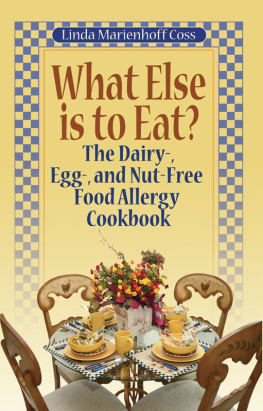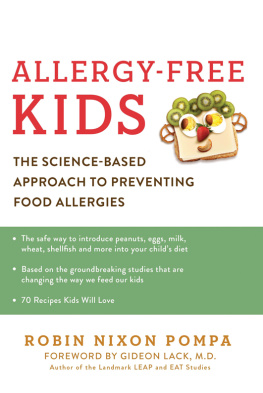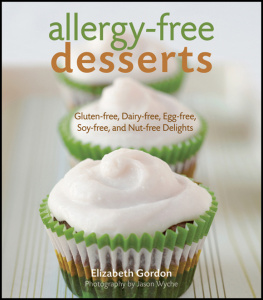
The Library of Congress has cataloged the earlier edition as follows:
Harris, Mary, 1953.
My kids allergic to everything dessert cookbook : sweets and treats the whole family will enjoy / Mary Harris and Wilma Nachsin; forewords by Rebecca Hoffman and Ida Mary S. Thoma.
p. cm.
Includes index.
ISBN 1-55652-303-3
1. Food allergy in childrenDiet therapyRecipes. 2. Desserts. I. Nachsin, Wilma, 1954-. II. Title.
RJ386.5.H37 1996
618.929750654dc20
96-42047
CIP
Cover and interior design: Andrew J. Brozyna, www.ajbdesign.com
Cover photo: Kelly V. Brozyna
1996, 2010 Wilma Selzer Nachsin and Mary Harris. All rights reserved.
Foreword 1996 Dr. Rebecca S. Hoffman. All rights reserved.
Foreword 1996 Dr. Ida Mary S. Thoma. All rights reserved.
Published by Chicago Review Press, Incorporated
814 North Franklin Street
Chicago, Illinois 60610
ISBN 978-1-56976-533-3
Printed in the United States of America
5 4 3 2 1
CONTENTS
Appendix I: Common, Scientific,
and Family Names
Dr. Rebecca S. Hoffman
When I was asked to write a foreword for this cookbook, I was pleased that another resource would be available to help my patients with food allergies. As we all know, adhering to special dietary constraints is very difficult, especially for children. This cookbook will hopefully broaden the menu choices available and provide some inspiration for developing many new recipe alternatives.
Food allergies manifest themselves in many ways: skin rashes such as eczema, nasal congestion, runny nose, frequent upper respiratory infections, hives, headaches, asthma, even life-threatening anaphylaxis.
Infants and very young children with allergies are often sensitive to foods, the most common sensitivities being egg, milk, wheat, soy, corn, and peanut. Children and adults may also have additional reactions to inhalant allergens, such as dust mites, molds, pollens, and animal dander.
One clue to look for when you think someone in your family has food allergies is an itchy, red, scaly skin rash, especially on the face or neck, or inside the elbows or behind the knees, that persists for weeks or months and may wax and wane over time. The rash may flare up after the individual eats a particular food, but sometimes this is too subtle to see. Another clinical sign of allergies in general is a cold that wont go awayrunny, stuffy nose, cough, and fatigue. Asthma can also be a problem; this can be manifested by coughing, wheezing, shortness of breath, or a tight or congested chest. These symptoms occur either in a seasonal pattern or after exposure to a specific allergen such as a cat, exposure to a cold, or exercise.
Food allergyinduced asthma can also be part of the syndrome of anaphylaxis, which is a severe and sudden allergic reaction resulting in multiple symptoms such as hives, low blood pressure, difficulty breathing, and abdominal cramping and diarrhea. Food anaphylaxis is a life-threatening type of food allergy.
As you can see, food and inhalant allergies can show up in many different ways. The first step is to be suspicious of an allergy, either because of the nature of the symptoms or because of a family history of allergies. Next, you should look carefully at the possible allergens: foods, dust, dander, etc. Then work with your pediatrician, internist, family practitioner, or allergist to identify the problem areas. A good story of the symptoms, a complete physical examination, and a few selected tests should pinpoint the most likely offending allergens. Finally, working with your physician through elimination of foods and/or decreasing exposure to other environmental allergens should help toward eliminating chronic symptoms. For food allergies, elimination of the offending items is the only current proven method of symptom relief. Sometimes this is very difficult to accomplish, especially if the allergy is something as all-pervasive as wheat or egg. That is where this book offers hope and practical help.
The one good thing about food allergies is that, with strict avoidance, some children will eventually lose their sensitivity to a food. However, some food allergies do persist for life. Depending on the severity of the original reactions, repeat testing and even controlled food challenges can be done periodically to test for continued allergies.
Knowledge about the problem and perseverance in its treatment can usually control food and other allergies relatively well. As of yet, there is no cure for allergies, but with continued research, we may hope for medical breakthroughs.
Dr. Ida Mary S. Thoma
How wonderful for a child to have tasty snacks and fun foods without itching or wheezing! A happy, stress-free person (child or adult) is more apt to outgrow allergic manifestations. I wish that I had just such a cookbook as this one when I was dealing with food allergies in my family.
I have found through personal and family experiences that food allergies may cause a variety of symptoms. In our family, the hives and eczema (atopic dermatitis) suffered by one of our children was suspected to be caused by a food allergy. Our family doctor, S. C. Lavine, initially sent us to a dermatologist who chose to treat only the symptoms. Knowing of my background in immunology, Dr. Lavine then suggested that I track down the offending allergens, those foods that caused the dermatitis.
As eliminating one food at a time did not alleviate the symptoms, we knew that more than one food was involved. We then resorted to the following method, which I recommend be used under your doctors guidance and with his or her approval.
Keep a food diary. After one week of listing all foods eaten, eliminate completely a selected food that has been eaten daily from the diet for four or five days. For example, if wheat is the test food, eliminate all wheat in any form. On the fourth or fifth day at breakfast (or at least eight hours after any other foods have been ingested), the test food only, in its purest form, should be eaten. For example, cream of wheat cereal, seasoned with salt only.
The person being tested should be observed for allergic reactions. If the food is indeed an allergen, within fifteen to thirty minutes one or more symptoms may occur: itching, a burning sensation, chills, a headache or an aura of bright lights or spots before the eyes, swelling of the nasal passages, wheezing, and perhaps, within an hour or so, diarrhea. If no symptoms occur, there is no strong allergy to the test food. We have found that if there is a strong allergic reaction, a dose of milk of magnesia will hasten the riddance of the allergen from the body.
To summarize the procedure that was successful for us:
- The test food must be eaten daily for one week before the test.
- The test food must then be eliminated completely from the diet for four or five days.
- The test food alone must be given to the subject after he or she has fasted for at least eight hours. A single food is tested at one time. I allowed twenty-four hours or longer between tests, and tested only at breakfast.
- The person must be observed carefully for at least forty to sixty minutes after ingesting the food.
In this way I found that our daughter was allergic to corn, oatmeal, and lamb (including lanolin in hand creams, as well as wool).














